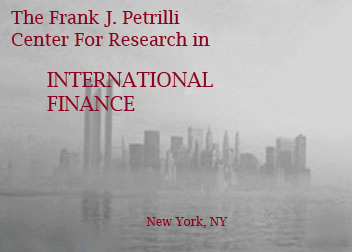Disciplines
Finance and Financial Management
Abstract
This paper compares the behavior of real interest rate differentials across the major countries under the Bretton Woods regime and the regime of floating exchanges that replaced it. The primary object is to investigate both the extent of market integration and its changes over time. For all fifteen possible country pairs real interest differentials are mean reverting, and in two-thirds of these cases indistinguishable from zero statistically. For all country pairs on average and for most such pairs individually, moreover, the estimated differentials are not appreciably different in absolute value than the differentials that we estimate for various money-market rates within the United States. Additional evidence points to a narrowing of differentials under floating rates over time and an increase in speeds of convergence. “The rate of interest plays a central role in two great branches of economic science, – the theory of prices, and the theory of distribution. The role of the rate of interest in the theory of prices applies to the deter mination of the prices of wealth, proper ty, and services.” Irving Fisher (1907, p. 225). In an integrated world economy, real rates of interest on physical assets will tend to converge. So too will real rates of interest on financial assets like bonds, which are much more dir ectly observable. Real interest rate equalization is, therefore, the broadest, and arguably most theoretically appealing, of the various measures of financial integration. In this paper, we examine the behavior of cross-countr y real interest rate differentials for the United States and five other major industrial countries vis-à-vis one another during the last decade and a half of the Bretton Woods period and under the current regime of floating rates that replaced it. We investigate both the extent of financial market integration per se and whether and how it may have changed through time. We focus on three issues specifically: whether real interest rate differentials, if not literally zero, are at least small in absolute value and hence consistent with financial integration in the presence of crosscountry differences in risk; whether they are mean reverting, and hence indicative of long-run equilibrium; and whether and how their behavior has differed across exchange-r ate regimes. As a first step in this investigation, we examine separately the time-series behavior of the individual countries' real interest rates and their nominal rate and inflation components. We find after allowing for a structur al break in 1980 that real inter est rates in the six countries are stationary. We find further that cross-country differentials are invariant to the change in regime. Fluctuations in differentials occur periodically over the sample period, but while somewhat persistent, in the end prove transitory. For all fifteen possible country pairs real-interest- rate differentials are mean reverting, and in two-thirds of these cases indistinguishable from zero statistically. Additional evidence points to a narrowing of these cross-country differentials through time and an increase in speeds of convergence. Has international financial integration, therefore, increased? Some of this evidence suggests that it has; almost none suggests the opposite. Viewed from an absolute standpoint, moreover, the degree of integration appears to be not drastically different from what one finds comparing the behaviors of spreads between the nominal rates yielded by different domestic financial instruments. If the markets for these instruments can be considered well integrated, as they commonly are believed to be, then the implication is obvious -- so also international markets.
Recommended Citation
Goldberg, Lawrence G.; Lothian, James R.; and Okunev, John, "Has International Financial Integration Increased?" (2002). CRIF Working Paper series. 13.
https://research.library.fordham.edu/crif_working_papers/13

